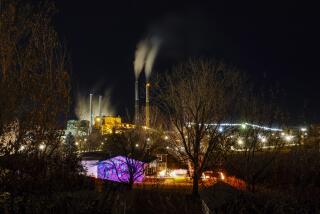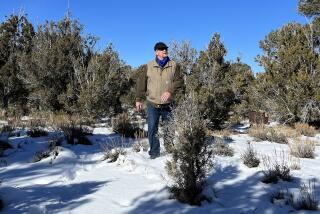Battered Nevada Town Finally Feels a Hint of Shifting Economic Winds
ELY, Nev. — When the huge Kennecott copper smelter shut down in 1983 and its 750-foot stack no longer belched sulfur dioxide fumes into the clear skies, there was every possibility that this community of 4,500 people in the remote eastern stretches of Nevada might become another mining ghost town.
That still could happen, but energetic local leaders, helped by state and federal officials, are working hard to prevent it.
“There are a lot of hopeful things on the horizon,” druggist and civic leader Art Olson said recently. “I just hope we can hold on till they get here.”
Among them are plans by the state of Nevada to build a 500-bed maximum-security prison 10 miles north of Ely that would provide about 500 construction jobs and 230 permanent jobs afterward.
And next summer, a new “historical railroad” is scheduled to open, offering steam locomotive rides for tourists.
Large mining companies are also showing renewed interest in exploring for gold around Ely, now that the price has climbed to about $400 an ounce on world markets and the South African supply is in doubt because of that country’s political troubles.
In the next few years a national park--Nevada’s first--will take shape in the South Snake Mountains, about 60 miles east of Ely.
In addition, the Los Angeles Department of Water and Power and 13 other utilities are considering building a large, coal-fueled power plant in the area.
“I think we’ve hit close to bottom, and we’re going to start moving the other way,” said George L. Carnes, general manager of the Ely Daily Times (circulation 2,350). “But I hesitate to say that because every time I’ve said it in the past, something else happened to us.”
A few days after Carnes spoke, Ely suffered another blow when financial problems forced the closing of the Hotel Nevada, one of the community’s four casinos.
Ely’s difficulties began in 1978, when Kennecott Minerals Co. closed its huge copper mine in Ruth, a few miles east of Ely, because “costs had accelerated to the point where we were not able to compete in the world market,” said Ralph N. Orgill, superintendent of Nevada operations for Kennecott.
From 1978 to 1983 the company continued to operate a smelter in McGill, 11 miles north of Ely, using copper from other mines and building a 750-foot stack to meet new environmental standards by carrying sulfur dioxide fumes higher into the air.
But in 1983, Orgill said, “further deterioration of the copper market meant there was just nothing left to smelt, so we had no alternative but to put the smelter in mothballs and wait for better times.”
This meant that a mine and mill that 15 years ago produced 60,000 tons of copper a year and employed 2,000 people to do it fell silent, leaving Orgill and a staff of nine to rattle around in the empty Kennecott buildings.
“We were a one-industry town,” druggist Olson said. “Almost overnight, we lost 2,000 jobs and an $18-million payroll.”
Kennecott still owns about 54 million tons of unmined ore at Ruth and more than 90 million tons of copper tailings at McGill. But with copper prices at only 60 to 65 cents a pound, Orgill said, it is “unrealistic to even think about reopening.”
At about the same time, livestock prices fell, hurting the cattle and sheep ranchers who were a small but steady source of revenue for Ely and surrounding White Pine County.
“Cattle has been a losing proposition for the last four years,” said Bob Dickenson, who grazes about 700 cows on a 3,000-acre ranch 30 miles west of Ely.
Prices are low, Dickenson said, because Americans are eating less beef while production costs have risen and more beef is being imported, among other factors.
Like many women in the area, Dickenson’s wife, Ellie, has gone back to work, teaching three Basque sheepherder’s youngsters in a one-room school and also teaching an English class at the small Ely branch of Northern Nevada Community College.
For a time, as Kennecott was shutting down, oil exploration took up some of the slack. Some good producing areas were found in Railroad Valley, 70 miles south of Ely, but then oil prices tumbled and both exploration and production ceased.
According to U.S. Census figures, the population of White Pine County dropped from 10,150 in 1970 to an estimated 7,888 in July, 1985. About 4,500 people are believed to live in Ely.
In McGill, where the union hall is boarded up and only a few stores remain open, population has fallen from 2,400 to about 800.
“Just about everybody has been blown away who could be blown away,” said Kent Harper, editor of the Ely Daily Times.
Schools and businesses have closed. Even the town’s three brothels have suffered. One has closed, at least temporarily. A prostitute at the Green Lantern, one of the two still open, complained one recent evening that she had been unable to make enough money the previous week to buy a bus ticket out of town. (Brothels are legal in White Pine County, as they are in most of rural Nevada.)
But “the community has done reasonably well under some very adverse circumstances,” said Carnes, the newspaper’s general manager. “The attitude of the business people, as well as the general public, has been very good. There is a strong feeling that this area has a lot of potential.”
Under the leadership of the Chamber of Commerce, an economic diversification program has begun and, so far, it has attracted half a dozen small new businesses to the county.
“We’re looking for small businesses--companies that are making their first move to the West and that have low transportation costs,” said Karen Rajala, who is coordinating the campaign.
Transportation costs are a factor because “we’re a long way from things,” said Mayor Barlow N. White, an insurance agent.
Ely has had no rail service since Kennecott shut down its Northern Nevada Railroad, which connected the mine and the mill with Southern Pacific and Western Pacific tracks about 100 miles north.
Western Express, a subsidiary of Western Airlines, flies into Ely three times a day and there are two buses a week along U.S. 50, which Life magazine in its July issue called “the loneliest road” in the country.
The most positive recent economic development has been increased gold mining, best seen at the Amselco Minerals Inc. mine at Alligator Ridge, 70 miles northwest of Ely.
Amselco miners do not enter deep shafts with pick axes on their shoulders and lights on their helmets.
This is open-pit mining, done by huge earth scrapers. More than a million tons of material a year is processed, yielding about 60,000 ounces of gold.
Most of Amselco’s 140 workers are bused to and from Ely. The miners, mostly former Kennecott copper miners, work 10-hour shifts, four days a week, and are paid about $14 an hour, plus medical and other benefits.
The Amselco deposits are expected to be exhausted by next July, but other companies are mining nearby and there is extensive exploration in the region.
“Although this has been a good deposit, we feel the Mother Lode is somewhere else,” said Bob Martinez, Amselco’s general manager.
There is still a gold assay office in Ely, a reminder of the Old West, but the owners have had to take on the local Culligan water-softening franchise, and also operate a roofing and siding business, to survive.
Construction of the new maximum-security prison is to begin next spring, in the face of some local opposition.
“To put it very bluntly, if you had your druthers, you’d rather not have a prison,” said Albert C. Gianoli, who has been with the First National Bank of Ely since 1937 and is now its president. “People are concerned that it might bring a lot of undesirables in here.”
Although the closing of the Hotel Nevada cost Ely another 65 jobs, two other motel-casinos--the Jailhouse (where every room is a numbered “cell” and there are bars on the restaurant windows) and the Copper Queen--seem to be doing well. Both have expanded recently.
Gianoli said gambling and tourism account for about 30% of the local economy.
Tourism should get a boost from the new national park in the Wheeler Peak area east of Ely, where there is a glacier and some of the state’s few remaining stands of bristlecone pine.
“The national park will be a big factor in our development,” said Ferrel Hansen, executive vice president of the Chamber of Commerce. “I think we’re on the brink of becoming a destination tourism area and not just a pass-through point.”
Hansen said the White Pine Historical Railroad, using equipment donated by Kennecott, will begin small local trips next summer and might someday run “gambling trains” to Elko, 185 miles north, and Wendover, 200 miles away on the Nevada-Utah state line.
The local trips are feasible, said Carson City railroad historian Richard C. Datin, but longer excursions are unlikely because of the high cost of repairing the abandoned Northern Nevada Railroad track.
A consortium of 14 utility companies, led by the Los Angeles Department of Water and Power, for several years has been considering construction of a coal-burning power plant 48 miles north of Ely.
The 1,500-megawatt plant would cost about $2.5 billion and would provide an estimated 3,000 jobs during construction and about 500 permanent jobs, according to Eldon Cotton, assistant chief engineer for power systems at DWP. About half of the electricity would come to Los Angeles.
But Cotton said lower oil prices, greater availability of surplus power from the Northwest and other factors have made the project less economically desirable than it was a few years ago.
“We have the project in a holding pattern,” he said, adding that construction probably would not begin until the 1990s, even if more favorable economic circumstances should develop.
As a mining community, Ely has long been accustomed to “boom and bust” cycles. The trouble is, the closing of the Kennecott mine and smelter was a colossal bust and there is no sign of a new boom.
“I’m afraid it’s going to be another tough winter,” Mayor White said.
More to Read
Sign up for Essential California
The most important California stories and recommendations in your inbox every morning.
You may occasionally receive promotional content from the Los Angeles Times.










